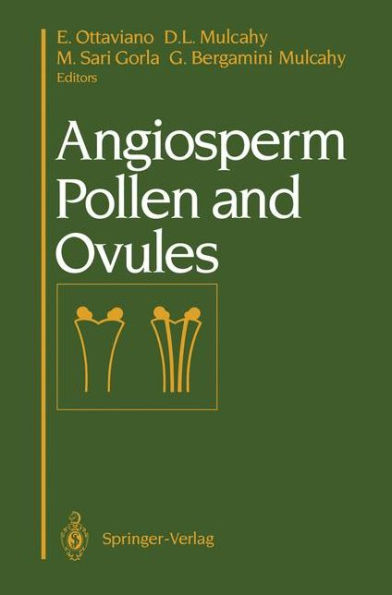Angiosperm Pollen and Ovules
The subject of this volume is the reproductive biology of plants. A steadily growing interest in this field is the result of at least two factors, as pointed out with great foresight by one of the driving forces in the field, H.E Linskens (Linskens 1964): most of the food consumed by humans takes the form of plant reproductive parts, and molecular biology now provides pow erful tools for investigating and manipulating plant reproductive systems. Molecular biology and the allied discipline of biotechnology are solidly represented in the papers in this book. The editors of Angiosperm Pollen and Ovules believe that the chapters herein contain some of the most excit ing findings of contemporary biology, and hope that the readers of this book will share their enthusiasm. The editors express sincere and grateful thanks for help from Carla Frova, Enrico Pe, and especially to Giorgio Binelli, all of the University of Milan. Without these three tireless and enthusiastic individuals it would not have been possible to maintain the apparently effortless proceeding of this congress. We thank also the organizing committee and the organizations that generously provided financial support (both listed below). Finally, we extend thanks to M. Cresti, D. Charlesworth, D. Hess, E Hoekstra, R. Bruce Knox, J.P. Mascarenhas, M.E. Nasrallah, P.L. Pfahler, A. Snow, and M.T.M. Willemse for chairing sessions.
"1000959045"
Angiosperm Pollen and Ovules
The subject of this volume is the reproductive biology of plants. A steadily growing interest in this field is the result of at least two factors, as pointed out with great foresight by one of the driving forces in the field, H.E Linskens (Linskens 1964): most of the food consumed by humans takes the form of plant reproductive parts, and molecular biology now provides pow erful tools for investigating and manipulating plant reproductive systems. Molecular biology and the allied discipline of biotechnology are solidly represented in the papers in this book. The editors of Angiosperm Pollen and Ovules believe that the chapters herein contain some of the most excit ing findings of contemporary biology, and hope that the readers of this book will share their enthusiasm. The editors express sincere and grateful thanks for help from Carla Frova, Enrico Pe, and especially to Giorgio Binelli, all of the University of Milan. Without these three tireless and enthusiastic individuals it would not have been possible to maintain the apparently effortless proceeding of this congress. We thank also the organizing committee and the organizations that generously provided financial support (both listed below). Finally, we extend thanks to M. Cresti, D. Charlesworth, D. Hess, E Hoekstra, R. Bruce Knox, J.P. Mascarenhas, M.E. Nasrallah, P.L. Pfahler, A. Snow, and M.T.M. Willemse for chairing sessions.
109.99
In Stock
5
1

Angiosperm Pollen and Ovules
465
Angiosperm Pollen and Ovules
465Paperback(Softcover reprint of the original 1st ed. 1992)
$109.99
109.99
In Stock

Product Details
| ISBN-13: | 9781461277330 |
|---|---|
| Publisher: | Springer New York |
| Publication date: | 10/10/2011 |
| Edition description: | Softcover reprint of the original 1st ed. 1992 |
| Pages: | 465 |
| Product dimensions: | 6.10(w) x 9.25(h) x 0.04(d) |
From the B&N Reads Blog
